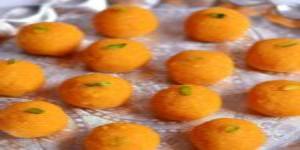
Scope
Laddu or laddoo is a round/spherical shaped sweet. The name is said to have originated from the Sanskrit word Lattika. Laddus are made of flour, ghee/butter/oil, and sugar/jaggery, with other ingredients that vary by recipe, like chopped nuts or dried raisins. They are often served at festive or religious occasions. Laddoos are the most popular sweet dish from the vast cuisine of India and a favorite offering as prasad/naivedyam in temples across the sub-continent as well
as in all major Hindu celebrations such as births, naming ceremony, weddings, etc.
Fundamental Concepts and Principles
Following ingredients are required for making Motichoor Laddoo :
- Laddu can be prepared from a variety of grains, legumes or seeds, sugar/jaggery and ghee. Some popular ones include laddu made with roasted wheat, amaranth, garden cress seeds, fenugreek seeds, and peanuts respectively.
Fundamental Concepts and Principles
Brown sugar – 2 veesai
Pure water – 1 and ½ padi
Milk – 1/8 padi
Saffron – one-rupee coin size
Ghee – 2 palam
Powdered salt – ¼ palam
Ghee for frying – 20 palam
Almonds – 5 palam
Raisins – 2 and ½ palam
Powdered rock sugar – 5 palam
Method
The required flour is combined with sugar and other flavorings, cooked in ghee and molded into a ball shape. Some laddu recipes are prepared using Ayurvedic medicinal ingredients, such as methi (fenugreek seed) laddu, multigrain and resin laddu. Dry fruits such as raisins, cashew nuts, pistachios and almonds are commonly added into laddus.
Of all laddus, the most famous is the boondi laddu which is a staple offering at Hindu temples, weddings, and Hindu festivals. Of these, the Tirupati Laddu of the Tirupati Tirumala Devasthanam is the most famous and greatly sought after. The second most popular laddu is the besan laddu made of chickpea (besan) flour, sugar and ghee.
Other well known laddus include rava laddu (made from semolina), til laddu (made from sesame seeds), pinni laddu (made with wheat flour) and coconut laddu.
A less known but nutritious laddu given to lactating mothers is the gond laddu/dink laddu. These laddus are called dinkache ladoo in Marathi and gond ka laddu in Hindi. The main ingredient is gum arabic which is collected from the babhul tree. Other ingredients in the gond laddu include coconut, almonds, cashews, dates, spices such as nutmeg and cardamom, poppy seeds, ghee, and sugar. An alternative multigrain recipe will have a portion of gum replaced by grains and legume flours such as besan, urid, ragi (nachani in Marathi) and wheat.
Method
- Make sugar syrup with brown sugar (2 veesai), pure water one and ½ padi, milk 1/8 padi, water 1/8 padi, saffron. Mix all these ingredients, refer to the second sugar syrup making method.
- Grind chana dal thinly to a flour and set aside in a vessel. Ghee 2 palam and powdered salt ¼ palam to the chana flour and add enough water or milk to make a batter like pancake. Pour this into a coated tray. Press this with the palm of your hand to make it string like.
- Heat 30 palam ghee in a pan. Take a ladle full of the flour mixture and transfer it to a sieved ladle. Hold it straight to the heated ghee. Keep a stone or wooden block as high as the pan. Pat the stem of the ladle with the flour mixture, on to the stone or wooden block. By doing this, the boondi will fall into the heated ghee evenly as far as possible. Turn the boondis with another sieved ladle until it is cooked well. Remove and set aside. Then dip the other ladle into water and remove it. Again take the flour mixture and repeat the process. After all the boondis are done make them into balls or laddus.
- You can add deskinned almonds, cleaned raisins, pepper sized crushed brown sugar. If the consistency of the flour is hard, you can loosen the flour by dipping the ladle in water and kneading the flour with that little water drops.
- The boondis are done in smaller hole ladles where the holes are more. And the flour is made like curry and should not be tight. Fry almonds, brown sugar, raisins and ½ palam cloves in ghee and put it in the sugar syrup or boondis before making the ladoos.
Hindu Compliance Body
The Hindu compliance body was established under the executive order of The Supreme Pontiff of Hinduism, dated August 14, 2020, order number 10010, under the title Reviving the Hindu Compliance System and Body
to create, promote, spread and teach the standard procedures for all products and services that are in compliance Hindu Shastras.
Copyright
HCS has the copyright of all its publications. No part of these publications may be reproduced in any form without the prior permission in writing to HCS. This does not preclude the free use, in the course of implementing standard, of necessary details mentioned above. Enquiries related to copyrights to be addressed to KAILASA.
